The team formation is key to winning a game in soccer, so check out our guide to some of the main formations so you know your 4-4-2 from your 3-5-2.
'Diamonds' and 'Christmas trees' aren’t the first things that spring to mind when thinking about football, but when it comes to tactical formations employed by managers, these phrases describe just some of the options and tactics considered by many a coach plotting their side’s potential route to victory.
Soccer formations refer to how players in a team are positioned on the pitch, and are decided according to how defensive or how attacking a side wants to be. For example, a manager who sees that the opposition has some dangerous attacking players may opt for an additional defender – and therefore one less midfielder or forward – in the lineup to nullify that threat.
Teams are always trying to second-guess what tactics and formations the other teams are going to use in an attempt to outwit them on the pitch. In fact, it’s often the case that a change in formation by one side during a game results in a swift change by the other team to compensate for the change.
Formations are arrived at using the ten outfield players (i.e. all the players apart from the goalkeeper), and they describe the number of players in each area of the pitch, from the defence and then working upfield.
4-4-2 Formation
The most well-known example of a football formation is 4-4-2. This refers to:
- Four defenders
- Four midfielders
- Two forwards
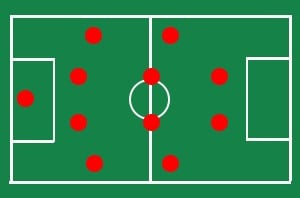
However, if one of the defenders were to be pushed into a midfield role during a match, then the side would then be playing in a 3-5-2 formation.
Other formations can be described with three numbers, although four-numbered (for example 4-4-1-1) and occasionally five-numbered (for example 4-3-1-1-1) formations can also be used. These are really just slight variations on the three-numbered formations though.
Having already explained the 4-4-2 setup, we have compiled a list of some of the most common other formations to help you get to grips with the tactical approaches available to teams:
The Diamond Formation
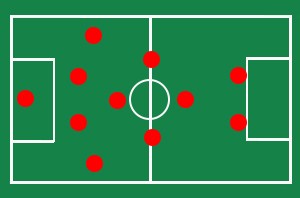
This is an example of 4-4-2 formation, but involves one of the two central midfielders playing in a more advanced position and another playing in a more withdrawn position. If you drew diagonal lines joining up the four midfielders it would make a diamond shape – hence the name!
___________________________________________
4-3-3 Formation
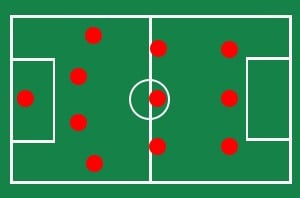
This is a relatively attacking formation employing three players in more advanced roles. The 4-3-3 formation often involves using two wingers and a striker in the forward positions. Not many teams use this formation from the start of a game, although they may often switch to it if they are losing and in desperate need of a goal!
___________________________________________
5-3-2 Formation
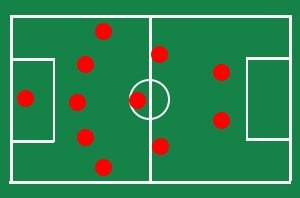
A defensive formation in which there are three central defenders and two wing-backs operating in the defence. The wing-backs are then expected to perform both attacking and defensive duties. This formation can be attacking or ultra-defensive depending on the ambition of the wing-backs.
___________________________________________
4-5-1 Formation
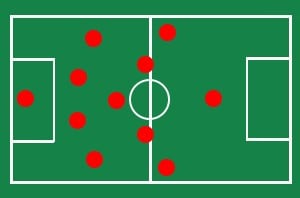
It is often said that many football games are won or lost in the midfield battle. 4-5-1 sees five midfielders operating in an attempt to win and keep possession of the ball in midfield, while just one striker is employed up front. This tactic is often used if a side has a lead and is attempting to stifle the opposition and prevent them getting back into the game.
___________________________________________
The Christmas tree (4-3-2-1) formation
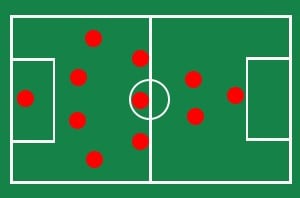
This is another variation of the 4-4-2 formation. If you picture it, 4-3-2-1 has four defenders, three midfielders, and two creative forwards who play just behind the most forward striker – so with a bit of imagination, it forms the shape of a Christmas tree!
___________________________________________
4-4-1-1 formation
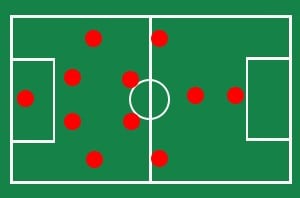
Another variation of 4-4-2 employing four defenders, four midfielders, and one striker playing in the area in front of the midfield but slightly behind the most forward striker – which is known as ‘in the hole’.
A final word on football formations
There are plenty of other combinations out there and it is worth remembering that the formations are not rigid and can change throughout a game. Unlike games such as netball, for example, the players in football are not confined to any specific zone on the pitch, but are free to go wherever they like (or wherever their manager tells them to go).
A team that is losing may opt to play a more attacking formation like 4-3-3, whereas a team that is winning or is content to hold onto what they have may opt to switch to a more defensive formation such as 4-5-1. Sometimes a side will seem to be switching so frequently that you might not even be able to tell what formation they are using!
Of course, if a team is losing in the last few minutes of game, then it may seem like they are playing 0-0-10 (and even the goalkeeper may get involved) as everyone pushes forward in a frantic effort to claim an equaliser!














